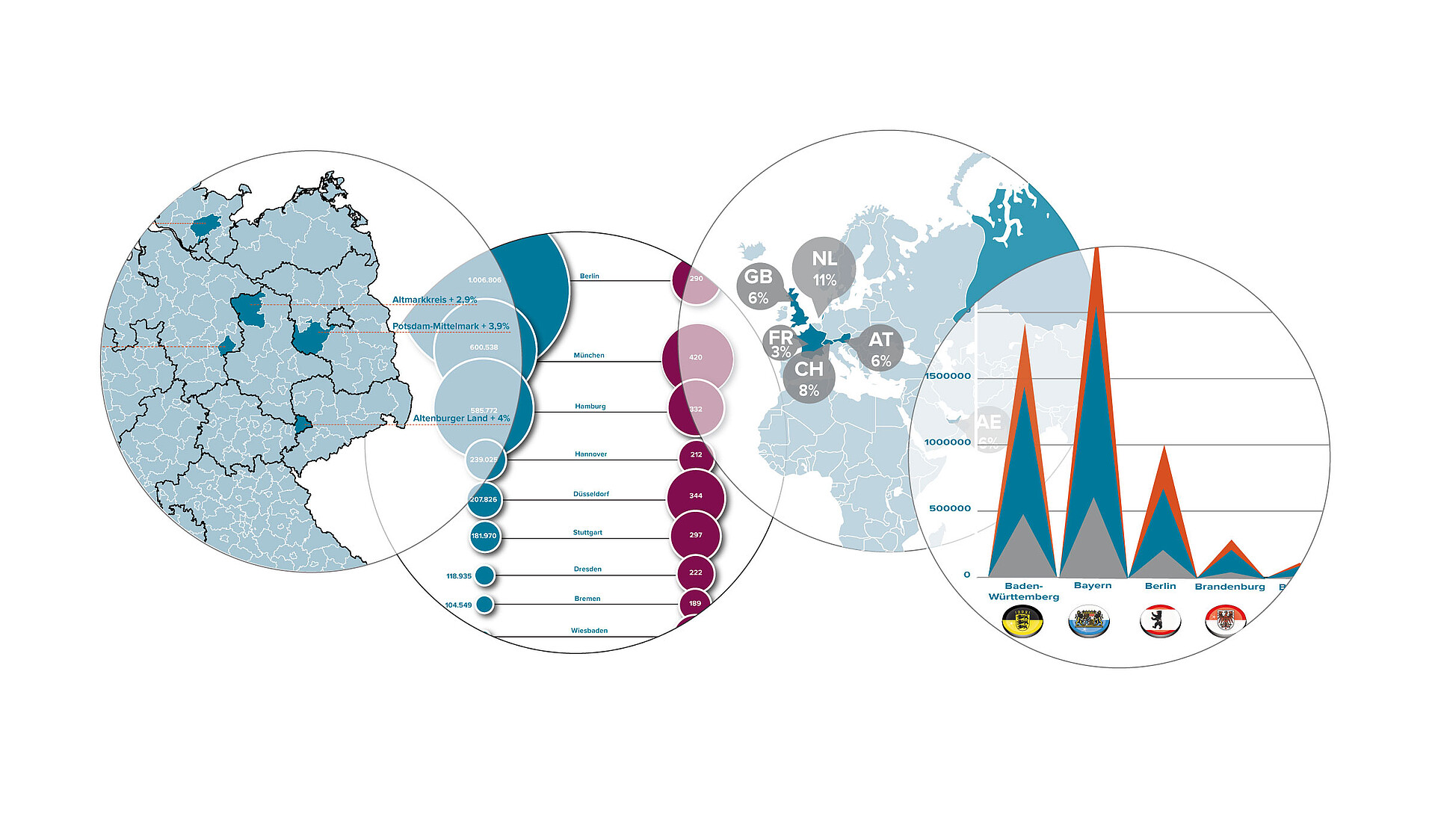You find them in every village, every district and in the German metropolises anyway – domains with the German ending .de are registered virtually everywhere in Germany. Their precise distribution is mapped every year in the annual regional domain statistics published by DENIC. The registry managing all domains with the ending .de now presents the results of 2016. As of 31 December 2016, about 14.9 million .de domains were registered in 402 cities and districts of Germany. Adding to these numbers are more than 1.1 domains of holders whose place of resi-dence is abroad. In total, more than 16.1 million .de domains were registered at the end of 2016. Domain development was moderate and confirmed the East-West divide of regional .de domain distribution within Germany.
Municipal Level: Majority of .de Domains in Metropolitan Regions
Looking at absolute domain numbers, one still finds three metropolitan regions in the top ranks. The undisputed number one in the overall ranking of the cities, Berlin, passed the one-million mark in 2016. With 1,006,806 domains, it maintains its leading edge on Munich (600,538) and Hamburg (585,772). When referring the number of .de domains to the number of inhabitants, Osnabruck comes first again: With 1,516 .de domains per 1,000 inhabitants, it still is far ahead of all its competitors. Like last year, Munich (420) and Bonn (413) complement the top trio of cities. In regard to the administrative districts, the frontrunners are located in the South of Germany again, namely Bavaria: Freising (436 domains) overtakes Starnberg (406) and is in the lead now; the district of Munich (377) comes third again. The national average has stabilised at 183 .de domains per 1,000 inhabitants (higher individual statistical values reflect local domain investors with larger-scale domain portfolios).
Regional Level: Domain Growth in East and West Germany Approximating
Consistency is also observed for the ranking on the federal-state level for the number of domains related to inhabitants. The state of Hamburg ‑ comprising the city of Hamburg and its wider outskirts ‑ with 332 domains per 1,000 inhabitants maintains its uncontested leading position and stays far ahead of Berlin (290) and the state of Bavaria with its vast lands (207). As in the preceding year, the state of Saxony-Anhalt (83) brings up the rear after the states of Mecklenburg-Vorpommern and Thuringia with 106 and 108 domains per 1,000 inhabitants respectively. The national growth rate (0.49 percent) was below that of 2015 (1.28 percent). In 2016, all federal states of the eastern part of Germany, except for Sachsen and Brandenburg, exceeded the average growth rate. Looking at the complete German territory, a total of ten federal states scored values above the mean value, with Bremen (+2.3%) and Lower Saxony (+2.2%) in the lead. Negative growth was found only in West Germany in 2016, i.e. in Schleswig-Holstein (-2.8%), Hamburg (-1.1%), Bavaria (-0.2%) and North Rhine Westphalia (-0.1%). Excluding Berlin, the average domain growth among the states in the East of Germany (+0.50%) was almost level to that of those in the West (+0.44%). Related to absolute numbers, the so-called Free State of Saxony with 525,441 registered .de domains achieved the highest density among the federal states in the East of the country and was number ten in the overall German ranking. North Rhine Westphalia (3,294,917 domains) and Bavaria (2,630,613 domains) remained on ranks one and two.
International Level: Growing Popularity of .de Also Beyond German Borders
The year-on-year total domain growth rate for 2015/2016 was 0.7 percent compared to 1.3 percent in 2014/2015. This is an increase by about 105,000 domains (previous year: 198,000). Fur-thermore, the 16.01 million .de domains that were registered at the end of 2016 included 1,146,500 domains of holders residing outside of Germany (2015: 1,114,358). This corresponds to 7.1 percent of the total number of domains registered under .de. The holders of .de domains originate from 217 countries. As in the past, German domains are particularly popular in the United States (24%), the Netherlands (11%) as well as in the Russian Federation (11%). But Germany's European neighbours Great Britain, Switzerland and Austria and also the United Arab Emirates account for 6 percent respectively of the .de domains with non-German-based holders, too. All in all, 16,114,504 domains were registered with DENIC on 31 December 2016. Statistically, every fifth inhabitant of the Federal Republic of Germany has registered a domain under the TLD .de. Thus, Germany consistently ranks fourth in the world after the Netherlands, Switzerland and Denmark.
Detailed online data available
You will find comprehensive data and graphic material as well as the complete regional analysis in form of an Excel file for all the 402 cities and districts in the statistics section of the DENIC website at https://www.denic.de/en/know-how/statistics/. We also make available the annual analyses since 1995. In addition to absolute values, the statistics provide data on the number of domains related to the number of inhabitants, complemented by maps and diagrams showing the absolute and the relative distribution of domestic domains as well as of domain holders residing outside of Germany.
